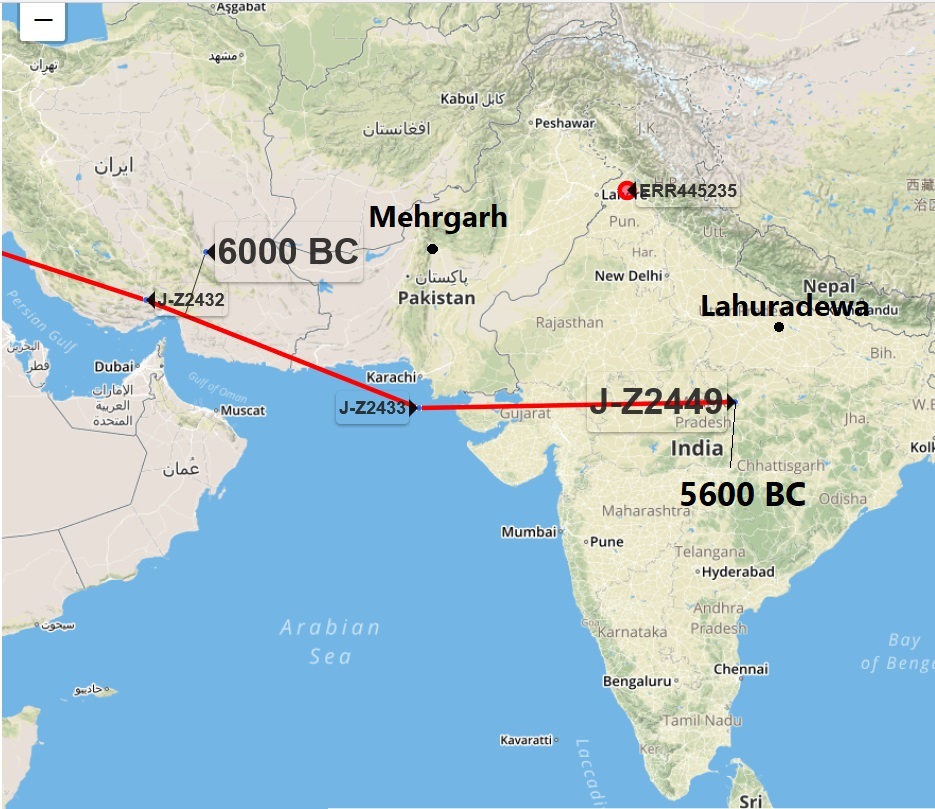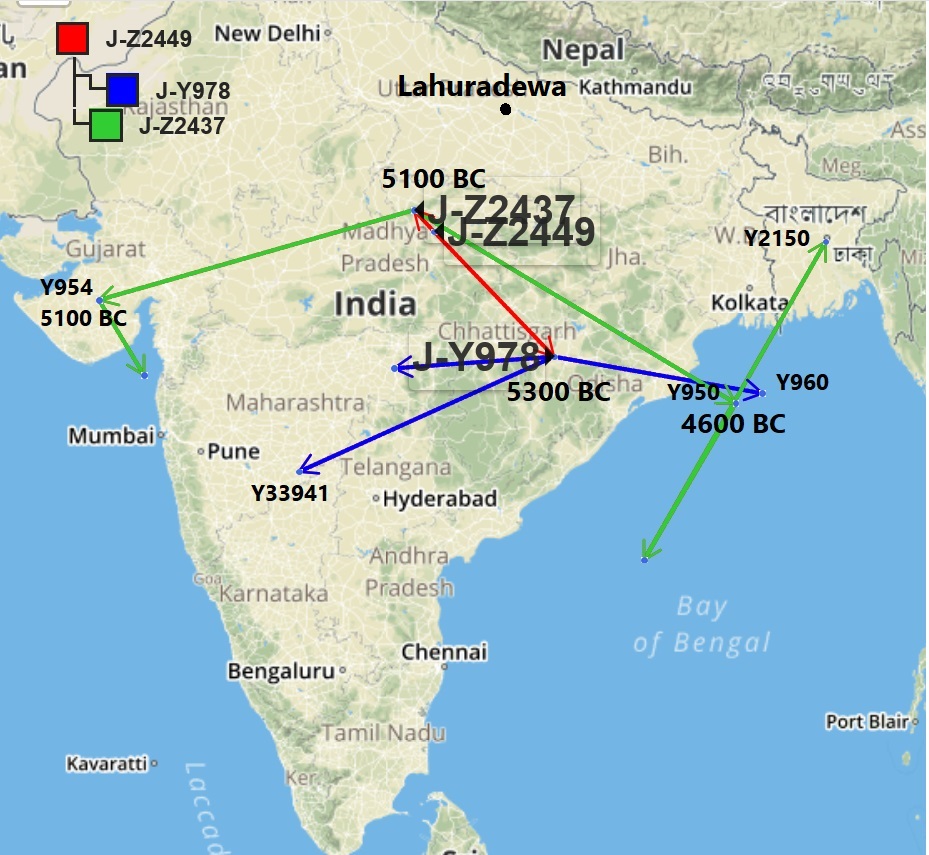The J-M241 ancestor is believed to have lived in West Asia, near Iran, Turkey or Iraq. In 7700 BC he had two sons, each of whose lineages migrated in different directions - one to Europe (J-L283) and the other to South Asia (J-Z2432).
Despite many lineages of J-Z2432 being present in the Middle East, especially Saudi Arabia and the Persian Gulf, some researchers have concluded that this presence is the result of a more recent back-migration from lineages that were established in South Asia. With a recent improvement to PhyloGeographer that takes bottleneck duration into account, the deeper origins of at least Z2449 are conclusively Indian.
Sublineages of J-Z2432 were first established 6200 BC and then again in 5600 BC. These early branching points may potentially lead us to a clearer picture of the migration to South Asia.

The calculated migration to Pakistan and northern India is a very rough estimate, not to be understood as a conclusive exact path. Two factors make the path calculation unreliable - lack of diversity in Y28235, Y28237 and unknown exact origin of J-M241. While the calculated migration shows Z2432 migrating from Iran, it is even possible that Z2432 was already further east - there is no conclusive evidence to rule it out, but it would necessitate two back-migrations to Syria and Azerbaijan in Y28235.
I provide the migration path anyway because it is clear that Z2449's ancestors did migrate from West Asia to South Asia where they founded many lineages around the time when agriculture was being introduced to the region.
"The Mehrgarh Period I (7000 BCE-5500 BCE) was Neolithic and aceramic, without the use of pottery. The earliest farming in the area was developed by semi-nomadic people using plants such as wheat and barley and animals such as sheep, goats and cattle." - Wikipedia
The Neolithic inhabitants of Mehgarh may have been the first dentists.
Wikipedia states that rice cultivation in Lahuradewa (S of Nepal) has been dated to 6400 BC referencing The Near-Eastern Roots of the Neolithic in South Asia.

It is a tempting trap to associate a lineage with the more well-understood cultures of a region, in this case the Indus Valley Civilization. However this was a Bronze Age civilization limited in extent to northwest India. The diversity of Z2449 dates back to the Neolithic and extends all over South Asia. So the theory that the ancestor lived in South Asia during the Neolithic should be considered if not favored as the most likely explanation.
1. Was there any evidence of J-M241 found in Mehrgarh?
2. If J-M241 was found in Mehrgarh, then what was the estimated date of the skeleton found?
No. The oldest ancient sample is a J-Z8344 from 800-1000 BC from Swat Valley.
However every subclade after Z2449, TMRCA 5600 BC, has deep diversity South Asia. So it’s a circumstantial-evidence-based argument that J-Z2449 was in South Asia by 5600 BC.
R1a1 is also spread throughout India and in fact, it has a presence in many tribes, and lowest castes. All major Y lineages in India are spread out deep. This is no reason to predict that J-Z2449 entered mainland India during the Neolithic. They haven’t found R1a1 in the Indus valley but they have found J2. So why are you implying that J-Z2449 entered deep into India during the Neolithic and is separate from other J2 lineages?
I created a new data visualization tool called Diversity Heatmap. Hit the link and click play button to see an animation showing the gradient increase. You can zoom in to see the individual samples.
https://phylogeographer.com/scripts/diversitymap.php?newlookup=Z2449
The data source are the geolocated samples on the YFull tree. Have you looked there? – https://www.yfull.com/tree/J-Z2449/
The oldest branches of J-Z2449 are mostly found in South Asia vs Arabia, which is sampled at 1000 times the rate.
So if it was not a coincidental comigration from much later, this is very strong circumstantial evidence that their ancestors were already in South Asia by the time of the MRCA, 7400 years ago.
This is a much different geographic distribution than the other branches of J2b.